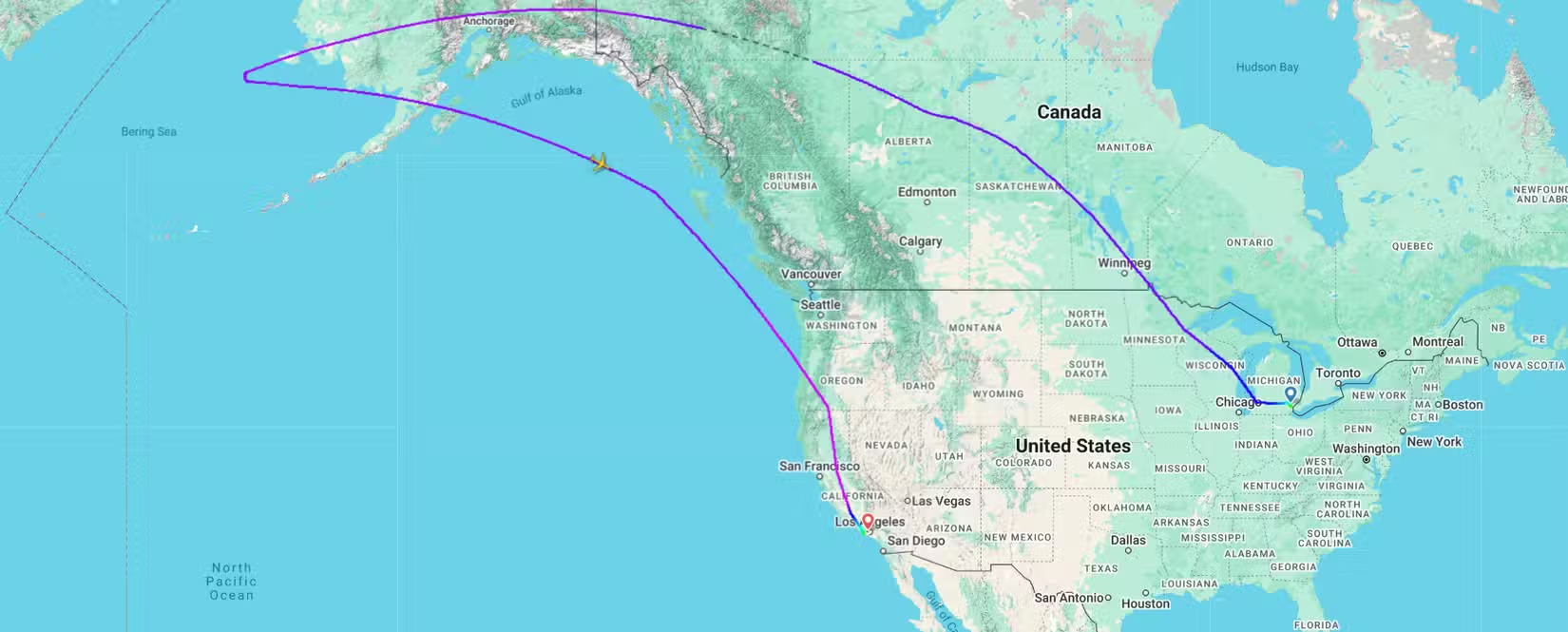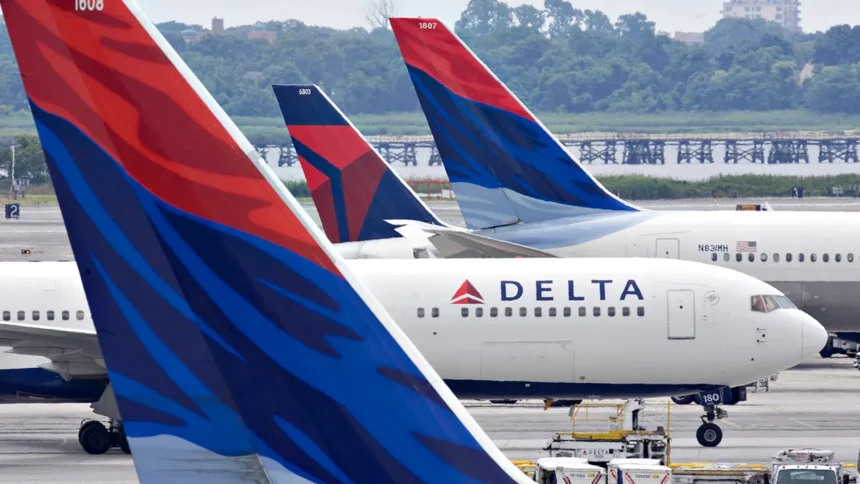An Unexpected Turn: What Happened on Delta Flight 275?
On the afternoon of May 27, 2025, Delta Air Lines flight DL275 pushed back from its gate at Detroit Metropolitan Wayne County Airport (DTW). For the crew and the more than 300 passengers on board, it was the start of a routine long-haul journey—a transpacific flight scheduled to land at Tokyo’s Haneda Airport (HND) roughly 13 hours later. The aircraft for this daily service was an Airbus A350-900, a modern, twin-engine widebody jet celebrated for its fuel efficiency and long-range capabilities, making it a workhorse for routes connecting continents.
The specific aircraft operating the flight, registered as N508DN, was a relatively young jet at just over seven years old, powered by two formidable Rolls-Royce Trent XWB engines. After an almost two-hour delay on the ground, the flight finally departed at 3:53 PM local time, climbing into the sky and setting a course northwest over Canada and toward the vast, remote expanse of the northern Pacific Ocean. For the first several hours, the flight progressed as expected, a tiny icon moving steadily across digital flight maps.

The turning point occurred approximately five hours into the journey. High above the frigid waters of the Bering Sea, somewhere southwest of Anchorage, Alaska, the flight path on tracking websites like Flightradar24 suddenly deviated. Instead of continuing its westward arc toward Japan, the aircraft made a decisive, sweeping turn to the southeast. The new destination was not a nearby Alaskan airfield but Los Angeles International Airport (LAX), thousands of miles away. This was no minor course correction; it was a full-blown diversion that would add many more hours to the flight.
What followed was a long and perplexing journey to a destination no one had planned for. The Airbus A350 flew for another five hours, tracing a long diagonal line across the Pacific and down the West Coast of North America. When flight DL275 finally touched down on runway 06R at LAX in the early hours of May 28, it was 1:08 AM local time. The total time spent in the air was a staggering 12 hours and 15 minutes. In a strange twist of aviation logistics, the passengers had endured a flight nearly as long as the one to Tokyo, only to find themselves back in the United States, a continent away from where they started and an ocean away from where they were supposed to be.
The Critical Failure: Why the A350 Had to Divert
The decision to reroute a transoceanic flight is never taken lightly. It initiates a complex and costly chain of events, reserved only for situations where the safety of the aircraft, its passengers, and crew is compromised. For DL275, the trigger was a seemingly technical but critically important issue: a malfunction in one of the Rolls-Royce Trent XWB engine’s anti-ice systems. While it may not sound as immediately alarming as engine failure or fire, in the context of high-altitude flight over remote, icy regions, it represents a serious threat.
An engine anti-ice system is a fundamental safety feature on all modern jet aircraft. It works by bleeding scorching hot air—often reaching temperatures between 400 to 600 degrees Fahrenheit—from the engine’s compressor stage and ducting it to the engine inlet cowl and other critical surfaces. This process prevents the formation and accumulation of ice, which can be catastrophic. As an aircraft flies through clouds at high altitudes, it can encounter supercooled water droplets that freeze instantly on contact with a cold surface. If ice were to build up on the engine inlet, it could break off and be ingested by the engine, potentially causing severe damage to the fan blades, disrupting airflow, and leading to a loss of thrust or even a complete engine shutdown. TheFederal Aviation Administration (FAA) explicitly warnsthat such events can lead to significant power loss or engine upset.
“At high altitude over cold regions (e.g., the Bering Sea), ice crystals and supercooled droplets can accrete within the engine… large deposits may cause temporary power loss or damage; hence crews follow conservative procedures, including diverting to the nearest suitable airport when protection is degraded.”
For the pilots of DL275, the warning light indicating a failure in this system presented a non-negotiable scenario. They were flying over one of the most remote and inhospitable environments on the planet. Continuing the flight to Japan would have meant spending several more hours over the icy Pacific with a compromised safety system. The flight crew, adhering to standard operating procedures and a safety-first doctrine, made the professional and correct call. The risk of an icing encounter, however small, was unacceptable. The only responsible course of action was to divert to an airport where the issue could be safely addressed. The diversion was not a moment of panic, but a calculated, procedural response to a critical system failure, demonstrating the robust safety culture that underpins modern aviation.
Strategic Choice: Why Los Angeles and Not a Closer Airport?

When flight DL275 turned southeast over the Bering Sea, a logical question arose for those watching on flight trackers: Why Los Angeles? Airports in Alaska, like Anchorage (ANC), or even in the Pacific Northwest, such as Seattle (SEA), were geographically much closer. The answer reveals a core principle of airline operations: the concept of the “nearest suitable airport.” In an emergency, “suitable” is far more important than “nearest,” and suitability is defined by a combination of safety, technical capability, and passenger logistics.
Los Angeles International Airport (LAX) was the strategic choice for several compelling reasons, transforming it from a distant point on the map to the most logical safe harbor. First and foremost is maintenance and engineering. LAX is a major “fortress hub” for Delta Air Lines, which means it houses a significant `TechOps` maintenance facility. This base is equipped with the specialized tooling, diagnostic equipment, and, most importantly, the certified engineers required to service an Airbus A350 and its Rolls-Royce Trent XWB engines. As multiple reports noted,Rolls-Royce technicians are also available at LAX, ensuring that the specific expertise needed to troubleshoot the anti-ice system was on hand. Diverting to a smaller, regional airport would have meant flying in specialists and parts, causing much longer delays.
The second critical factor was passenger recovery. With over 300 passengers displaced, the airline faced a massive logistical challenge. A major international hub like LAX is built to handle such disruptions. Delta has a large customer service staff at LAX, extensive gate capacity, and established relationships with local hotels. This infrastructure allows the airline to efficiently rebook hundreds of passengers onto alternative flights, provide meal vouchers, and arrange accommodations—a task that would have overwhelmed a smaller airport. Choosing LAX was a decision made not just for the health of the aircraft, but for the welfare of its passengers, minimizing their inconvenience as much as possible under the circumstances.
Finally, LAX had the operational capability to handle the aircraft itself. An Airbus A350 diverting mid-journey is still a very heavy aircraft, likely carrying a substantial amount of fuel intended for a 13-hour transpacific flight. LAX features multiple long runways, including runway 06R where DL275 landed, which can safely accommodate a heavy widebody landing. This combination of world-class maintenance infrastructure, large-scale passenger handling capabilities, and robust airfield facilities made LAX the undisputed “most suitable” airport, despite the extra flying time required to get there. It was a textbook case of operational risk management, prioritizing a comprehensive solution over a simple geographic shortcut.
The Ripple Effect: The True Cost of a Diversion
A single flight diversion triggers a cascade of financial and logistical consequences that ripple through an airline’s intricate network. The decision to divert DL275, while essential for safety, came with a formidable price tag. While airlines rarely disclose the exact cost of such incidents, industry analysis provides a clear picture of the financial impact. A high-end estimate, considering all direct and indirect costs, places the total financial loss for this single event at approximately$2.3 million.
This figure is composed of several layers of expense. The most immediate costs are operational: the extra fuel burned during the five-hour detour to Los Angeles, landing and handling fees at LAX, and overtime pay for the flight and cabin crew. Beyond that are the significant costs of passenger care. For over 300 travelers, Delta was responsible for providing hotel accommodations, meals, and transportation. The largest financial hit, however, comes from maintenance and lost revenue. The cost of inspecting and repairing the sophisticated Trent XWB engine, including parts and specialized labor, is substantial. Furthermore, the cancellation of the high-yield Detroit-Tokyo flight and the disruption to the aircraft’s subsequent schedule (known as breaking a rotation) result in millions of dollars in lost ticket revenue. An aircraft on the ground is an asset not generating income, and the knock-on effect can disrupt schedules for days.
Beyond the balance sheet, the diversion had a profound human impact. For the passengers, the experience was one of confusion, exhaustion, and significant disruption. A planned arrival in Tokyo was replaced by an unexpected, middle-of-the-night landing in Los Angeles. Business meetings were missed, family reunions delayed, and carefully planned vacations thrown into disarray. While Delta’s crew was praised for their professionalism and the airline moved to provide care and rebooking options, such events inevitably test customer loyalty.One report suggestsan airline risks losing up to $2,800 in future bookings per passenger if trust is eroded. The incident underscores the critical importance of transparent communication and effective customer service in mitigating the reputational damage of a major disruption.
The experience serves as a tangible reminder that the global aviation system is a tightly wound clockwork mechanism. A single fault in one component can cause a system-wide tremor, affecting hundreds of people and costing millions of dollars. It highlights the immense pressure on airlines to balance safety, operational efficiency, and customer satisfaction, where one decision can impact all three.
A Glimpse into the Future: Could This Have Been Prevented?

While the crew of DL275 responded flawlessly to an in-flight issue, the incident raises a more profound question: in an era of unprecedented technological advancement, could the problem have been caught before the aircraft ever left the ground? The answer, increasingly, is yes. This diversion serves as a powerful case study for the transformative potential of predictive maintenance in aviation.
Modern aircraft like the Airbus A350 are flying data centers. On every single flight, they generate a massive amount of information—up to 2.5 terabytes according to some analyses—from thousands of sensors monitoring every aspect of the aircraft’s health in real-time. Predictive maintenance leverages this data, using artificial intelligence (AI) and machine learning algorithms to move from a reactive “fix-it-when-it-breaks” model to a proactive “fix-it-before-it-fails” approach. These systems analyze live data from an operating engine and compare it to historical data from thousands of previous flights, identifying subtle deviations and patterns that are invisible to human analysis.
In the “what if” scenario for DL275, a predictive maintenance system could have been the hero. It’s plausible that the anti-ice system’s malfunction did not occur suddenly. Instead, it may have been preceded by tiny, almost imperceptible anomalies in sensor readings over several flights—a slight fluctuation in valve speed, a minor deviation in airflow, or a fractional change in temperature. An AI-powered Engine Health Monitoring (EHM) system, like the one Rolls-Royce uses for its Trent engines, is designed to detect exactly these kinds of faint signals.Experts suggest that such a system could have flagged an emerging issue 3 to 6 hours before takeoff. This would have triggered an alert for the maintenance crew in Detroit, allowing them to inspect and repair the component on the ground, during a scheduled turnaround. The flight would have likely departed late, but the in-flight emergency, the 12-hour detour, the massive costs, and the severe passenger disruption would have been avoided entirely.
This incident is not an indictment of Delta’s current maintenance practices, which follow rigorous industry standards. Rather, it highlights a pivotal shift occurring across the entire aviation industry. Airlines and manufacturers are investing heavily in predictive technologies like theAirbus Skywise platform and Delta’s own APEX engine program. The goal is to harness the power of data to make air travel not only safer but also more reliable and efficient. The story of DL275 is a compelling argument that the future of aviation safety lies not just in reacting to failures, but in predicting and preventing them altogether.
If Your Flight is Diverted: A Practical Guide for Travelers
Experiencing a flight diversion is a stressful and disorienting event. While they are rare, knowing how to respond can make a significant difference. The DL275 incident provides a real-world context for understanding what to do if you find yourself on a flight that isn’t going to its planned destination.
First and foremost, stay calm and listen to the flight crew. A diversion is a decision made for your safety. The pilots and cabin crew are trained professionals who are following established procedures. They will be your primary source of information while on board. Once on the ground, the most reliable updates will typically come from the airline’s official mobile app and gate agents. Keep your phone charged and monitor the app for changes to your flight status and rebooking information. In the case of DL275, Customer Commitment obligates them to provide timely information within 30 minutes of becoming aware of a change.
It’s also important to understand your rights as a passenger. These are primarily governed by the airline’s “Contract of Carriage,” a legal document that outlines their obligations. For a diversion caused by a mechanical issue like the one on DL275 (a “controllable” disruption), airlines are generally responsible for taking care of their passengers. According to Delta’s policies, this typically includes rebooking you on the next available flight to your destination at no additional cost. If the delay is significant and requires an overnight stay, the airline will usually provide meal vouchers and hotel accommodations. If you are not satisfied with the rebooking, you may be entitled to a refund for the unflown portion of your ticket.
Finally, be diligent about documentation. Keep your original boarding pass, ticket receipt, and any new boarding passes issued to you. If you incur necessary expenses due to the delay—such as for meals or a taxi to a hotel if vouchers aren’t immediately available—keep all receipts. This documentation will be essential if you need to file a claim for reimbursement with the airline later. You can typically request refunds or file complaints through the airline’s official website, such as a refund request form. While no one wants to experience a diversion, being prepared and informed can help you navigate the situation with greater confidence and less stress.
Key Takeaways from the DL275 Diversion
- Safety First Protocol: The crew’s decision to divert was a textbook example of aviation’s safety-first culture. A compromised anti-ice system over a remote ocean is an unacceptable risk.
- The “Suitable” Airport: The choice of LAX over closer airports highlights that a diversion destination is chosen for its technical and logistical capabilities (maintenance, passenger care), not just proximity.
- High Cost of Disruption: A single diversion can cost an airline millions of dollars in operational costs, passenger care, and lost revenue, demonstrating the immense financial incentive for reliability.
- The Predictive Future: The incident is a powerful argument for the adoption of AI-driven predictive maintenance, which can identify potential failures before they occur in-flight, preventing disruptions.
Conclusion: Safety, Strategy, and Smarter Skies
The 12-hour journey of Delta flight DL275 from Detroit to Los Angeles is more than just a story of a flight gone awry; it is a microcosm of the modern aviation industry. It encapsulates the unwavering commitment to safety, the complex operational strategy behind managing disruptions, and the technological frontier that promises a more reliable future for air travel.
At its core, the incident is a testament to a system that worked exactly as it should. A critical technical failure was detected, and the flight crew executed a professional, safety-driven diversion, ensuring the well-being of everyone on board. The subsequent choice of Los Angeles was not a random decision but a masterclass in disruption management, where the long-term benefits of a fully-equipped hub outweighed the short-term appeal of a closer landing strip. It was a strategic move that balanced the immediate needs of the aircraft with the complex needs of its hundreds of passengers.
Ultimately, the story of DL275 is a powerful lesson. It reminds us that while the skies are safer than ever, the pursuit of perfection is relentless. The diversion was a costly and inconvenient event, but it serves as an invaluable data point for the entire industry, reinforcing the urgent need to shift from reactive to proactive safety. The future lies in smarter skies, where the vast streams of data flowing from every aircraft are harnessed to predict and prevent incidents before they happen. This single, unexpected turn over the Bering Sea may well be remembered as another catalyst that accelerated the journey toward that data-driven, safer, and more seamless era of global aviation.





